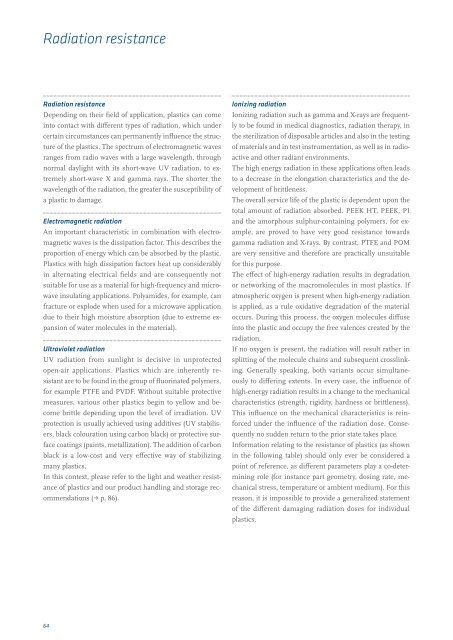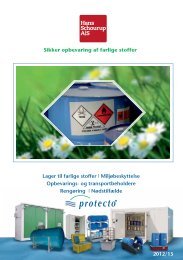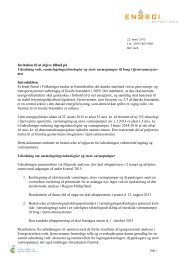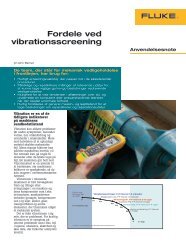Engineering plastics â The Manual - F.wood-supply.dk
Engineering plastics â The Manual - F.wood-supply.dk
Engineering plastics â The Manual - F.wood-supply.dk
You also want an ePaper? Increase the reach of your titles
YUMPU automatically turns print PDFs into web optimized ePapers that Google loves.
Radiation resistance<br />
Radiation resistance<br />
Depending on their field of application, <strong>plastics</strong> can come<br />
into contact with different types of radiation, which under<br />
certain circumstances can permanently influence the structure<br />
of the <strong>plastics</strong>. <strong>The</strong> spectrum of electromagnetic waves<br />
ranges from radio waves with a large wavelength, through<br />
normal daylight with its short-wave UV radiation, to extremely<br />
short-wave X and gamma rays. <strong>The</strong> shorter the<br />
wavelength of the radiation, the greater the susceptibility of<br />
a plastic to damage.<br />
Electromagnetic radiation<br />
An important characteristic in combination with electromagnetic<br />
waves is the dissipation factor. This describes the<br />
proportion of energy which can be absorbed by the plastic.<br />
Plastics with high dissipation factors heat up considerably<br />
in alternating electrical fields and are consequently not<br />
suitable for use as a material for high-frequency and microwave<br />
insulating applications. Polyamides, for example, can<br />
fracture or explode when used for a microwave application<br />
due to their high moisture absorption (due to extreme expansion<br />
of water molecules in the material).<br />
Ultraviolet radiation<br />
UV radiation from sunlight is decisive in unprotected<br />
open-air applications. Plastics which are inherently resistant<br />
are to be found in the group of fluorinated polymers,<br />
for example PTFE and PVDF. Without suitable protective<br />
measures, various other <strong>plastics</strong> begin to yellow and become<br />
brittle depending upon the level of irradiation. UV<br />
protection is usually achieved using additives (UV stabilisers,<br />
black colouration using carbon black) or protective surface<br />
coatings (paints, metallization). <strong>The</strong> addition of carbon<br />
black is a low-cost and very effective way of stabilizing<br />
many <strong>plastics</strong>.<br />
In this context, please refer to the light and weather resistance<br />
of <strong>plastics</strong> and our product handling and storage recommendations<br />
(• p. 86).<br />
Ionizing radiation<br />
Ionizing radiation such as gamma and X-rays are frequently<br />
to be found in medical diagnostics, radiation therapy, in<br />
the sterilization of disposable articles and also in the testing<br />
of materials and in test instrumentation, as well as in radioactive<br />
and other radiant environments.<br />
<strong>The</strong> high energy radiation in these applications often leads<br />
to a decrease in the elongation characteristics and the development<br />
of brittleness.<br />
<strong>The</strong> overall service life of the plastic is dependent upon the<br />
total amount of radiation absorbed. PEEK HT, PEEK, PI<br />
and the amorphous sulphur-containing polymers, for example,<br />
are proved to have very good resistance towards<br />
gamma radiation and X-rays. By contrast, PTFE and POM<br />
are very sensitive and therefore are practically unsuitable<br />
for this purpose.<br />
<strong>The</strong> effect of high-energy radiation results in degradation<br />
or networking of the macromolecules in most <strong>plastics</strong>. If<br />
atmospheric oxygen is present when high-energy radiation<br />
is applied, as a rule oxidative degradation of the material<br />
occurs. During this process, the oxygen molecules diffuse<br />
into the plastic and occupy the free valences created by the<br />
radiation.<br />
If no oxygen is present, the radiation will result rather in<br />
splitting of the molecule chains and subsequent crosslinking.<br />
Generally speaking, both variants occur simultaneously<br />
to differing extents. In every case, the influence of<br />
high-energy radiation results in a change to the mechanical<br />
characteristics (strength, rigidity, hardness or brittleness).<br />
This influence on the mechanical characteristics is reinforced<br />
under the influence of the radiation dose. Consequently<br />
no sudden return to the prior state takes place.<br />
Information relating to the resistance of <strong>plastics</strong> (as shown<br />
in the following table) should only ever be considered a<br />
point of reference, as different parameters play a co-determining<br />
role (for instance part geometry, dosing rate, mechanical<br />
stress, temperature or ambient medium). For this<br />
reason, it is impossible to provide a generalized statement<br />
of the different damaging radiation doses for individual<br />
<strong>plastics</strong>.<br />
64

















